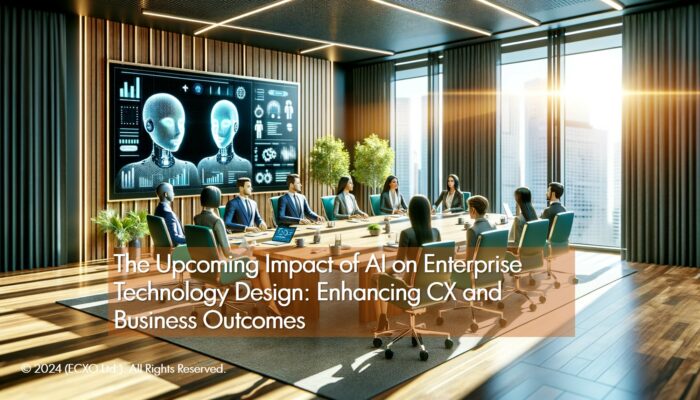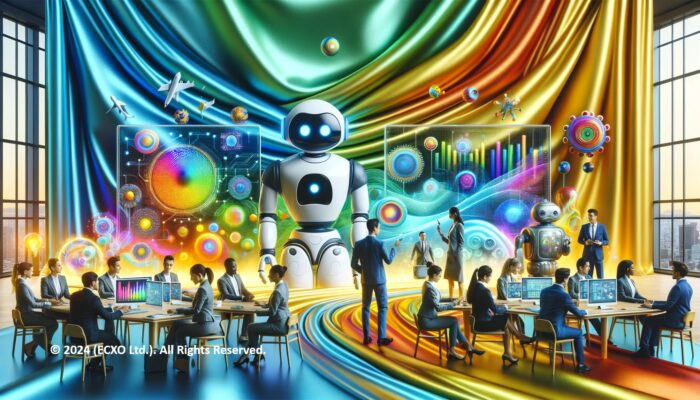
The Upcoming Impact of AI on Enterprise Technology Design: Enhancing CX and Business Outcomes
Source article: https://www.eglobalis.com/the-upcoming-impact-of-ai-on-enterprise-technology-design-enhancing-cx-and-business-outcomes/
Introduction
Artificial Intelligence is revolutionizing enterprise technology, and will redefine enterprise software design, and transform how businesses enhance customer, user experiences and drive business outcomes. While AI has infiltrated many aspects of enterprise software—from automating mundane tasks to delivering advanced data insights—it hasn’t fully integrated into the creative process of enterprise software design. This article explores the current landscape of AI in enterprise software, highlighting its growing impact on user adoption and its transformative potential to improve customer loyalty, streamline workflows, and reduce operational costs. By understanding how AI shapes the present and future of enterprise technology, businesses can position themselves to stay ahead, providing seamless customer experiences and unlocking new revenue opportunities.
Current State of AI in Enterprise Software Design
AI technologies have permeated many areas of enterprise software, from automating mundane tasks to offering complex data analyses and insights. However, it hasn’t yet empowered designers or engineers directly. Soon, with advanced algorithms, AI will not only be a tool but also an entity capable of wielding a design system. This could involve AI making or suggesting decisions based on design system guidelines and standards, understanding adoption parameters, and human-centered designs while generating code for new functionalities, features or components. The data algorithms we provide will shape this capability.
Designers and innovators at large technology companies need to prioritize solutions that adapt to human mental models to ensure easy adoption. Systems that can assist in enterprise design can help designers and engineers align their work with those parameters. Are companies already using this approach? Let’s see where we currently stand:
Efficiency and Better Design Outcomes

Early applications of AI focused on automating routine tasks like data entry and report generation or even chats conversational design. Today, AI-driven automation extends to complex operations like financial forecasting and resource management, reducing the time and human effort required. As AI progresses, it holds the potential to drastically reduce the time spent on routine tasks like code generation, component resizing, and style consistency checks. The focus will shift to functionality, adoption, and customer experience and its outcomes. This will mean no more wasted time.
Enhanced Data Analytics
AI algorithms excel at analysing large datasets quickly and accurately, providing actionable insights previously unattainable due to the sheer volume and complexity of the data. This ability supports improved decision-making and strategy development. However, human-centered design and mental models for more adoption, loyalty, and recurring revenue are not yet well explored. But they will be, and the organizations with effective algorithms will achieve superior designs that help them gain a larger market share.
We already have tools enhancing visual experiences and adding digital features, so let’s continue refining our approach. Although nothing can satisfy everyone, expanding market share with accessible and adoptable design remains crucial.
Adoption is the key in today’s business world, as everything depends on it. When it functions properly, all a company’s goals become achievable: adoption, loyalty, satisfaction, retention, revenue growth, and reduced churn.
Personalized User and Utilization of AI Experiences
Through machine learning, predictive analytics, and other algorithms, AI tools are gradually offering personalized user experiences. However, they are not yet adaptable to the level of an Amazon-like platform, where enterprise technology is tailored to each individual. Slowly, interfaces and functionalities are being personalized to enhance engagement and productivity.
AI will soon transform enterprise system design by interpreting and implementing design ideas and simplifying the UI creation process, leading to a significant leap in efficiency and human easy understanding and adoptability. AI-driven platforms can now establish foundational designs, managing aspects like spacing, typography, and colour scales but not yet exploring all its potential.
Major software companies such as Adobe and Microsoft are integrating AI step by step into their design tools and processes. Adobe’s Sensei platform automates repetitive tasks and provides intelligent suggestions. Microsoft’s Power Apps streamline app creation, making it easier for businesses to design tailored applications. By handling routine tasks, AI helps designers focus on innovation and creativity while ensuring a more efficient process.
The Future of AI in Enterprise Software Design

As AI technologies continue to evolve, they will improve enterprise software design. Key areas where AI will significantly impact include decision-making for better human adoption, automation of design components, enhancement of user experience through predictive analytics, understanding of mind models, and rapid prototyping and user interfaces and processes design for better adaptation for each human brain as advanced and fancy it may sounds. These more advanced tasks will be done by humans and AI and help designers focus on strategic and creative tasks helped by AI. While AI will also independently handle routine, technical aspects, leading to greater efficiency and innovation.

In the future of enterprise technology, personalization means the system will offer features that best support adoption for your specific mind model while avoiding complexities that hinder understanding. #cx…
As we evolve, we’ll reach this level, and although we’re not there yet, we will achieve it. – Ricardo S. Gulko
Predictive UI and UX Enterprise Design
Predictive UI and UX design, driven by data analytics, will enhance enterprise software by anticipating user needs, streamlining engagement, and simplifying interfaces. AI algorithms will soon be able to tailor layouts to individual users, reducing cognitive load and improving task efficiency. Predictive design leverages machine learning to identify trends and adapt frequently used features while minimizing less relevant elements. The interfaces will be more adaptable soon for our mind models meaning our way of perceive the reality.

Automated Development Processes
Emerging AI tools are transforming software development with automated code generation and sophisticated project management. These innovations speed up development while reducing the risk of human error. Automated design will streamline prototyping and enable rapid iteration, leading to more user-centric experiences.
Microsoft’s GitHub Copilot provides AI-based coding assistance, IBM’s Watson AI integrates data-driven decision-making in enterprise software, and Salesforce’s Customer 360 delivers personalized interactions. These companies illustrate how automation is changing enterprise tech, paving the way for fully automated processes.
Advanced Collaborative Tools
AI is advancing collaborative tools in enterprise systems, making them intuitive and better equipped to manage team dynamics and workflows. AI-enhanced tools analyse communication patterns and optimize project management by assigning tasks based on team strengths. They will adapt to individual and team preferences, offering personalized recommendations that improve workflow efficiency.
Companies like Slack integrate AI to facilitate smarter notifications and reduce noise. Google Workspace leverages AI for document drafting, while Figma’s FigJam organizes ideas into actionable workflows. These advancements transform collaboration and align stakeholders on project goals for future enterprise technology systems.
Impact on Adoption, Loyalty, Revenue, and Cost Savings
Faster Adoption and Reduced Training and Customer Success Investment
Adopting enterprise software quickly enhances an organization’s ability to harness the tool’s value while minimizing training and customer success costs. A well-designed user interface alongside with a well thought logical process and self-service knowledge bases accelerate onboarding, reducing the resources needed for complex features and boosting user satisfaction and loyalty.
Salesforce, Atlassian, and HubSpot all employ guided learning paths, tutorials, and certification courses to bolster adoption and reduce support needs.
Increased Customer Satisfaction and Revenue Growth
AI’s design capabilities will impact customer satisfaction, loyalty, and revenue growth through personalized strategies and intuitive experiences. By analysing user behaviour, AI can tailor recommendations to create relevant and frictionless experiences that delight customers. Proactive, personalized follow-ups and offers foster trust, deepening emotional connections and reducing churn.
Conclusion
AI’s expanding role in enterprise software design promises to deliver intuitive, personalized, and efficient user and customer experiences. This emerging technological partner will simplify workflows, optimizes decision-making, and boosts customer satisfaction and loyalty. The future of enterprise technology lies in fully embracing AI’s potential, ensuring businesses can harness its power to stay competitive. By leveraging AI effectively, organizations can align themselves with rapid digital transformation, drive adoption, reduce costs, and remain at the forefront of technological innovation.
Check out my previous related articles here:
- Simplifying CX Design: How Leading Enterprise Tech Firms Overcome Complex Challenges Part I https://www.eglobalis.com/simplifying-cx-design-how-leading-enterprise-tech-firms-overcome-complex-challenges/
- CX Design: What Can Companies Do to Compete with Tech Giants? – Part II https://www.eglobalis.com/simplifying-cx-design-what-can-companies-do-to-compete-with-tech-giants-part-ii/
- How to create better business outcomes through CX design https://www.eglobalis.com/how-to-create-better-business-outcomes-through-cx-design/
Explore my blog for innovative ideas that are transforming companies like Samsung, SAP, Software AG, Oracle, and more. Dive into the future of technology with us! https://www.eglobalis.com/blog/



